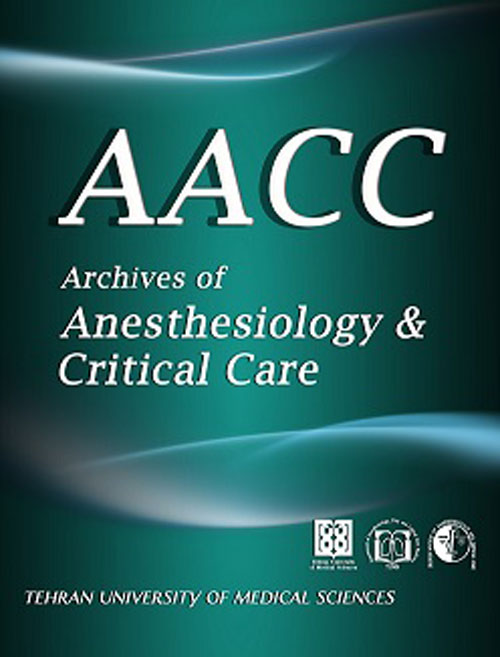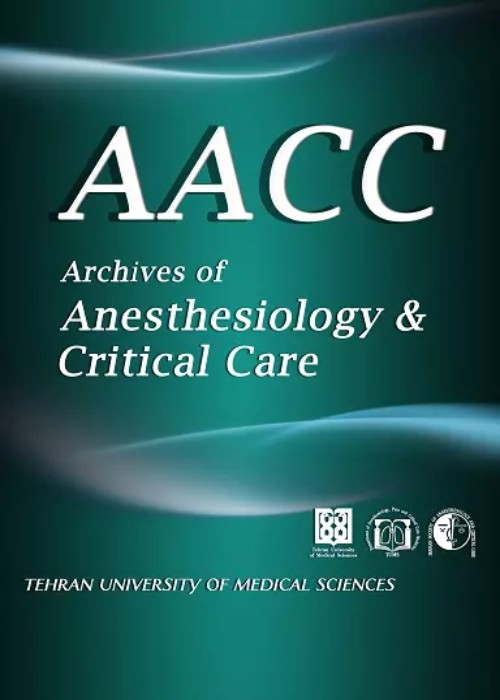فهرست مطالب

Archives of Anesthesiology and Critical Care
Volume:3 Issue: 4, Autumn 2017
- تاریخ انتشار: 1396/08/30
- تعداد عناوین: 9
-
-
Pages 365-372BackgroundThe present study has evaluated the effect of intrathecal Sufentanil and Meperidine on patients shivering after caesarean section.MethodsThe present study was a double-blind randomized clinical trial that was conducted on 120 patients. Spinal anesthesia was administered using 2 cc (10 mg) of bupivacaine along with 2.5 µg (0.5 cc) of Sufentanil for the first group, 25 mg (0.5 cc) of Meperidine for the second group and 0.5 cc normal saline for the control group.
The severity of patients shivering was recorded during the surgery and in the recovery room. Heart rate, respiratory rate, systolic and diastolic blood pressures, oxygen saturation, and core and skin temperatures were measured before anesthesia, 5th minute, 10th minute and then every 15 minutes until the end of the surgery and then every 15 minutes into the recovery until discharge from recovery. The Apgar score of the neonates were also recorded at the 1st and 5th minutes after birth.ResultsThe mean score of shivering was significantly lower in the Meperidine group (0.1 ± 0.07) than the Sufentanil group (1.2 ± 0.3) and the control group (4.1 ± 0.5) (p 0.05).ConclusionUsing intrathecal Meperidine and Sufentanil, besides decreasing the incidence of shivering (with more effectiveness from Meperidine), would also increase the block density and quality of relaxation in the patients. It would also lead to improved hemodynamic stability without affecting the sensory block level and infants Apgar score.Keywords: sufentanil, meperidine, caesarean section, shivering -
Pages 373-377BackgroundMaternal bradycardia and hypotension are the most common intraoperative complications after spinal anesthesia during cesarean delivery. Prophylactic administration of ondansetron has been reported to provide a protective effect. In this study we evaluated the effect of intravenous granisetron, another serotonin 5-HT3 receptor antagonist, on prevention of these complications.MethodsThirty-four ASA class I-II patients undergoing elective cesarean section under spinal anesthesia were randomly allocated into two equal groups, control saline (n=17) or granisetron groups (n=17). After insertion of standard monitorings,5ml/kg lactated Ringers solution was infused over 15 minutes. In saline group 3ml of 0.9% saline and in granisetrone 3mg (3ml) granisetron was injected intravenously five minutes before spinal anesthesia. Systolic and diastolic blood pressure and heart rate were all recorded every two minutes during first twenty minutes and then every five minutes until the end of surgery and compared between the groups.ResultsDemographic data and median of sensory block level were not statistically different between the groups. There was no statistical difference between the study groups regarding the systolic, diastolic and heart rate at measured points except at second minutes after spinal anesthesia that was lower in saline group (P=0.01).ConclusionThis study showed that intravenous granisetron has little protective effect on attenuation of hemodynamic responses of parturients undergoing elective cesarean section under spinal anesthesia.Keywords: cesarean section, granisetron, hemodynamic response, spinal anesthesia
-
Pages 378-381BackgroundPain relief is one of the most important goals in patients undergoing surgery without using high-dose opioid analgesics due to their complications. The aim of this study was to evaluate the effect of using low-dose ketamine after spinal anesthesia on the severity of postoperative pain in the patients with orthopedic surgery.MethodsThe present double-blind clinical trial after obtaining approval was performed on 60 patients with lower limb fracture. The patients were selected by convenience sampling method and then divided into two equal (n=30) intervention and control groups using random number table. The patients in the intervention group after spinal anesthesia received 0.2mg/kg intravenous ketamine diluted with 10cc normal saline. The same amount of normal saline was injected intravenously in the control group. Then, the intensity of pain using VAS and the level of need for analgesics were measured in both groups at different times up to 24 hours after surgery.ResultsThe intervention group included 21 males and 9 females with a mean age of 30 ± 1.2 years and control group consisted of 19 males and 11 females with a mean age of 29 ± 4 years. There was no significant difference between the age and sex of the patients in the intervention and control groups (P=0.677), (P=0.589). In the intervention group with the VAS, the lowest pain score was found at the first turn of the assessment (2.4 ± 0.6), and the highest pain at 24 h (4.3 ± 2.6). The control group had the lowest pain score at the first turn of the assessment (3.6 ± 0.8) and the maximum pain at the first turn of the assessment (5.2 ± 1.7). According to independent t-test, there was a significant difference between the two groups at all times, except for the first turn of the assessment. In the intervention group, 12 (40%) patients did not receive analgesics within 24 hours. In the control group, 2 (6.7%) had no analgesics. Chi-square showed a significant difference between the two groups (P=0.002).ConclusionThe present study showed that low-dose intravenous ketamine could relieve pain in patients and reduce postoperative analgesics.Keywords: ketamine, postoperative pain, orthopedic surgery
-
Pages 382-384BackgroundThe pain induced by intravenous injection of propofol is controlled using a variety of methods, but there is no consensus in choosing the best effective method. Therefore, this study was conducted to compare premedication injections of magnesium sulfate, ketamine and lidocaine on pain induced by intravenous injection of propofol.MethodsThe present double-blind clinical trial was conducted on 150 patients with elective orthopedic surgery under general anesthesia. The patients were randomly assigned into three groups of 50; Group I: 2 cc magnesium sulfate 20%, Group II: 2 cc Ketamine at a dose of 0.1mg/kg and Group III: 2 cc lidocaine 2% at a dose of 0.05mg/kg. One minute after injecting the drugs, 2mg/kg intravenous propofol was injected in all groups and then a trained unaware expert evaluated the severity of subsequent pain using a Numeric Pain Rating Scale.ResultsThe mean age of the patients was 39.3±12.3 years, and the mean weight was 67.4±11.5 kg. The patients consisted of 98 (65.4%) males and 52 (34.6%) females. Ten in the Group magnesium sulfate, eight in the Group ketamine and seven in the Group lidocaine complained of pain. The mean pain severity was 0.85±0.38 in the Group magnesium sulfate, 0.66±0.26 in the Group ketamine and 0.62±0.22 in the Group lidocaine (P=0.513).ConclusionThe Group lidocaine showed further pain relief compared to other two groups, but there was no statistically significant difference.Keywords: ketamine, lidocaine, magnesium sulfate, pain induced by injection of propofol
-
Pages 385-388BackgroundThis study aimed to determine the effects of two muscle relaxants, i.e. atracurium and cisatracurium, on airway pressure of pediatric patients during general anesthesia maintained by propofol.MethodsThis double-blind clinical trial included 68 two-five-year-old candidates for elective lower abdominal surgeries under propofol anesthesia. The patients were randomized to two groups to receive either atracurium or cisatracurium as muscle relaxant. The changes in airway pressures were evaluated during the procedure.ResultsPeak airway pressure from the 10th to the 45th minutes and plateau airway pressure from the fifth to the 45th minutes after the induction of anesthesia were significantly lower in the cisatracurium group (P = 0.005). Four patients (11.8%) from the atracurium group developed laryngospasm. However, the two groups had no significant difference in this regard (P = 0.11).ConclusionComparison of the two muscle relaxants showed that cisatracurium had lower peak and plateau airway pressure in pediatric patients under general anesthesia maintained by propofol.Keywords: muscle relaxants, general anesthesia, atracurium, cis-atracurium
-
Pages 389-393Volatile halogenated agents are essential for a balanced anesthesia but they do have significant effects on the cardiovascular system and these effects should be kept in mind during the course of anesthesia to avoid adverse effects and morbidity. An attempt to assess the mechanism of actions of the volatile agents on the cardiovascular system was included with this narrative study.Keywords: physiology, cardiovascular system, volatile anesthetic agents, cardiac index, heart, contractility, rhythm, heart rate, baroreceptor reflex, systemic vascular resistance
-
Pages 394-397A real time visualization of the peripheral nerves and adjacent anatomical structures, with ultrasound guidance, represents a new developmental technique in regional anesthesia and with more significance for pediatric patients. The main goal of this review was to explain the advantages of the ultrasound to guide the peripheral nerve block in the pediatric population for upper and lower limbs surgeries, and to show if there exists any superiority of the ultrasound technique over other traditional techniques in terms of increasing the success rate or reducing the rate of complications.Keywords: ultrasound guided, sonography, regional anesthesia, nerve block, pediatric
-
Pages 398-399A 42-year-old male with a 2-year history on dialysis for renal failure was admitted for adrenalectomy. We applied central venous catheter for this phaeochromocytoma case before the induction of anaesthesia. Although he had no weight change in his last dialysis, he was suffering severe volume depletion despite high arterial blood pressure. There was deep discrepancy between central venous and arterial blood pressure before and during anaesthesia of this patient. We strongly recommend central venous guided fluid management started before the induction of anaesthesia in these cases despite controversial studies.Keywords: phaeochromocytoma, renal failure, central venous pressure
-
Pages 400-402A 72-year-old woman who was a candidate for percutaneous dilatational tracheostomy (PDT) using the Ciaglia Blue Rhino single dilator was examined. After dilation, a stoma was created on the guide wire, but the dilator could hardly pass through and pulled in the endotracheal tube with it. Bronchoscopy was therefore performed. The guide wire that was inside the Murphy eye of the endotracheal tube was then removed. So the dilator and guide wire was removed. The endotracheal tube was pulled back slightly and the tracheostomy tube was inserted once again. Fiberoptic bronchoscopy is recommended in cases of a problematic anatomy or when the PDT tube placement is suspicious.Keywords: percutaneous dilatational tracheostomy, murphy eye, bronchoscopy, intraoperative complication


